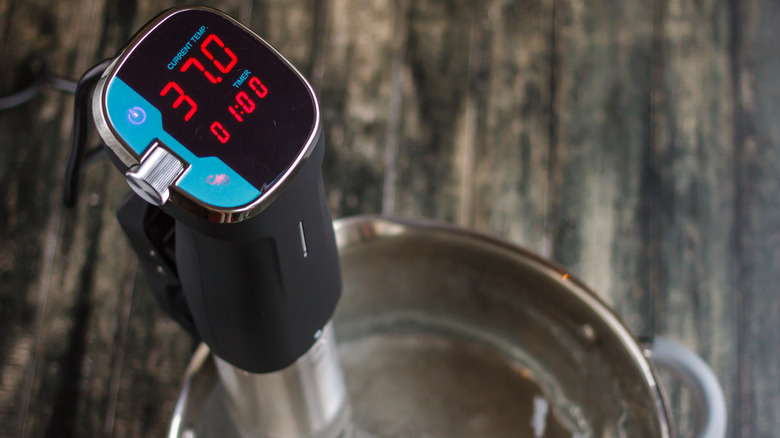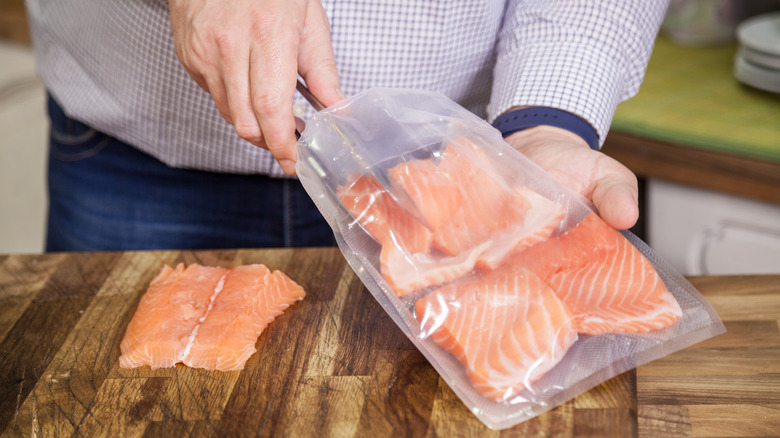The Complicated History Of Sous Vide
When you hear the word "sous vide" (pronounced sue-veed), you probably think of some fancy gadget that Michelin chefs use that's way out of your league, but its bark is worse than its bite.
To cook using the sous vide method, you essentially seal raw food in an airtight package and cook it in temperature-controlled water. You can add marinades, sauces, herbs, or spices into the pouch with the food to help enhance flavor, and once the pouch is submerged into the water (which never comes to a boil), it cooks low and slow, maintaining that perfect internal temperature until you're ready to pull it out of the water bath.
There's no contact with flame, metals, steam, or smoke. There are no pots to scrape in sous vide, and the cooking method actually preserves food for longer, making it super simple to try at home — all you need is an immersion stick. Now we see why restaurants use this method so much ... It gives peace of mind when cooking for hundreds! But who is the genius behind sous vide? That's up for debate.
Who is Ambrose McGuckian?
It dates back to the late '60s when costs of food, wages, equipment, and supplies were at an all-time high. In 1968, Col. Ambrose McGuckian was hired on a regional study by chemicals giant W.R. Grace (remember that name, it's important) to rebuild hospital food service for the Greenville Hospital System in South Carolina, explains Alice Popovici, McGuckian's step granddaughter, in a piece for NPR. McGuckian had been instructed to improve the quality of food while staying within budget. After studying several programs, he found a formula that boosted the taste of food while extending the shelf life. Alas, the sous vide method was born — in the United States.
Within this formula, McGuckian created water-bath cooking using an immersion circulator (normally found in science labs for incubating live cell cultures). Per Cook's Illustrated, immersing food sealed in a vacuum-packed pouch in heated water would not only prevent overcooking, but would also pasteurize and sterilize the food to prevent risk in a health-care setting. McGuckian had observed at the time, "This locked in flavor and streamlined food service" (via NPR).
Further, as Popovici explained, the food could be refrigerated for up to 60 days after and reheated when it was time to serve. McGuikian's invention helped to revolutionize meals for the Greenville Hospital System; most importantly, as Popovici noted, McGuikian reported at the time that patients were happy with the new way of preparing and delivering hospital food. But sadly, no one remembers her grandfather, Ambrose McGuckian, when it comes to sous vide.
Is this French technique actually French?
According to Cuisine Solutions, in the mid-1970s, two French chefs, Bruno Goussalt and George Pralus, each developed a version of sous vide with separate goals in mind. The two eventually partnered, however, making them both known as the "fathers of sous vide." Goussalt's vision was to improve the tenderness of roast beef, while Pralus wanted to prevent fois gras from shrinking as it cooked. They eventually teamed up with Cryovac to finalize the invention.
While the two chefs weren't aware of American Ambrose McGuckian's contributions, they knew of the Nacka System, which was the brain behind the production. The goal of Nacka was to prepare nutritious food in one location for hospital patients and distribute it to several locations using soft plastic developments. Except, this early process was in a different order: Items were cooked, vacuum-sealed, and chilled at one operation, then transported and boiled before serving, in hopes that the food would remain safe to eat and retain its flavor. However, this created bland, overcooked meals for the patients. McGuckian cracked the code by changing up the sequence.
The many fathers of sous vide
Now, here's where it gets tricky. Remember W.R. Grace? Well, Cryovac — the company that worked with Bruno Goussalt and George Pralus on finalizing the sous vide method — was a division of W.R. Grace, per NPR. Before sous vide was sous vide, Ambrose McGuckian had named it "the A.G.S. System" (via Cornell Hospital Quarterly) — named after A.G.S. Food System, Inc. (of which he was president in 1969) — which he later went on to patent. Here's the kicker: Cryovac claimed ownership due to McGuckian being hired as a contractor for them (via W.R. Grace) during development.
As McGuickian's step granddaughter Alice Popovici explains, in the early 1970s, an agreement was reached and A.G.S. became the formal assignee to the patent. McGuickian would later ask for his patent back, however, saying he would rather own the patent (which Cryovac had apparently said held little value) in his name, rather than receive a large stock offering. "The patent was important to my father because it was his baby and it was a significant development in the food industry at the time," said Ambrose's son, Paul McGuckian (via NPR).
With Cryovac now being owned by Sealed Air, Ambrose McGuikian's name is nowhere to be found when it comes to sous vide, when in reality, he should be mentioned together with the French fathers of sous vide, Bruno Goussalt and George Pralus.



